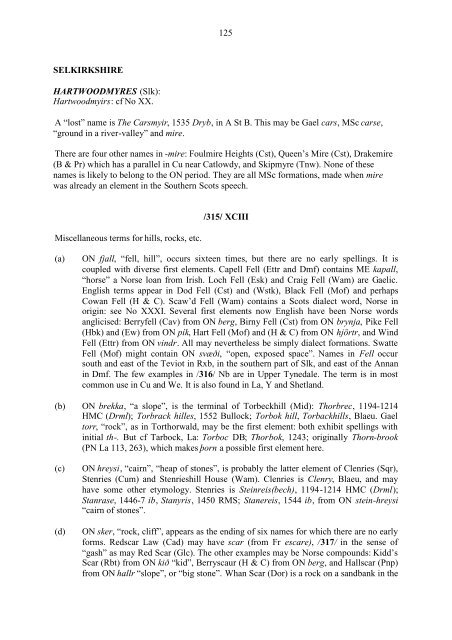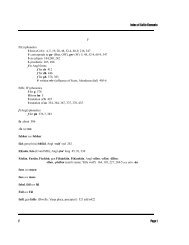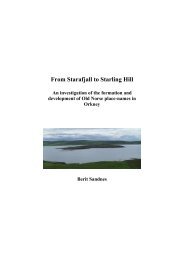May Williamson: The Non-Celtic Place-Names of the Scottish Border ...
May Williamson: The Non-Celtic Place-Names of the Scottish Border ...
May Williamson: The Non-Celtic Place-Names of the Scottish Border ...
You also want an ePaper? Increase the reach of your titles
YUMPU automatically turns print PDFs into web optimized ePapers that Google loves.
125<br />
SELKIRKSHIRE<br />
HARTWOODMYRES (Slk):<br />
Hartwoodmyirs: cf No XX.<br />
A “lost” name is <strong>The</strong> Carsmyir, 1535 Dryb, in A St B. This may be Gael cars, MSc carse,<br />
“ground in a river-valley” and mire.<br />
<strong>The</strong>re are four o<strong>the</strong>r names in -mire: Foulmire Heights (Cst), Queen’s Mire (Cst), Drakemire<br />
(B & Pr) which has a parallel in Cu near Catlowdy, and Skipmyre (Tnw). <strong>Non</strong>e <strong>of</strong> <strong>the</strong>se<br />
names is likely to belong to <strong>the</strong> ON period. <strong>The</strong>y are all MSc formations, made when mire<br />
was already an element in <strong>the</strong> Sou<strong>the</strong>rn Scots speech.<br />
Miscellaneous terms for hills, rocks, etc.<br />
/315/ XCIII<br />
(a)<br />
ON fjall, “fell, hill”, occurs sixteen times, but <strong>the</strong>re are no early spellings. It is<br />
coupled with diverse first elements. Capell Fell (Ettr and Dmf) contains ME kapall,<br />
“horse” a Norse loan from Irish. Loch Fell (Esk) and Craig Fell (Wam) are Gaelic.<br />
English terms appear in Dod Fell (Cst) and (Wstk), Black Fell (M<strong>of</strong>) and perhaps<br />
Cowan Fell (H & C). Scaw’d Fell (Wam) contains a Scots dialect word, Norse in<br />
origin: see No XXXI. Several first elements now English have been Norse words<br />
anglicised: Berryfell (Cav) from ON berg, Birny Fell (Cst) from ON brynja, Pike Fell<br />
(Hbk) and (Ew) from ON pík, Hart Fell (M<strong>of</strong>) and (H & C) from ON hjörtr, and Wind<br />
Fell (Ettr) from ON vindr. All may never<strong>the</strong>less be simply dialect formations. Swatte<br />
Fell (M<strong>of</strong>) might contain ON svæði, “open, exposed space”. <strong>Names</strong> in Fell occur<br />
south and east <strong>of</strong> <strong>the</strong> Teviot in Rxb, in <strong>the</strong> sou<strong>the</strong>rn part <strong>of</strong> Slk, and east <strong>of</strong> <strong>the</strong> Annan<br />
in Dmf. <strong>The</strong> few examples in /316/ Nb are in Upper Tynedale. <strong>The</strong> term is in most<br />
common use in Cu and We. It is also found in La, Y and Shetland.<br />
(b) ON brekka, “a slope”, is <strong>the</strong> terminal <strong>of</strong> Torbeckhill (Mid): Thorbrec, 1194-1214<br />
HMC (Drml); Torbrack hilles, 1552 Bullock; Torbok hill, Torbackhills, Blaeu. Gael<br />
torr, “rock”, as in Torthorwald, may be <strong>the</strong> first element: both exhibit spellings with<br />
initial th-. But cf Tarbock, La: Torboc DB; Thorbok, 1243; originally Thorn-brook<br />
(PN La 113, 263), which makes þorn a possible first element here.<br />
(c)<br />
(d)<br />
ON hreysi, “cairn”, “heap <strong>of</strong> stones”, is probably <strong>the</strong> latter element <strong>of</strong> Clenries (Sqr),<br />
Stenries (Cum) and Stenrieshill House (Wam). Clenries is Clenry, Blaeu, and may<br />
have some o<strong>the</strong>r etymology. Stenries is Steinreis(bech), 1194-1214 HMC (Drml);<br />
Stanrase, 1446-7 ib, Stanyris, 1450 RMS; Stanereis, 1544 ib, from ON stein-hreysi<br />
“cairn <strong>of</strong> stones”.<br />
ON sker, “rock, cliff”, appears as <strong>the</strong> ending <strong>of</strong> six names for which <strong>the</strong>re are no early<br />
forms. Redscar Law (Cad) may have scar (from Fr escare), /317/ in <strong>the</strong> sense <strong>of</strong><br />
“gash” as may Red Scar (Glc). <strong>The</strong> o<strong>the</strong>r examples may be Norse compounds: Kidd’s<br />
Scar (Rbt) from ON kið “kid”, Berryscaur (H & C) from ON berg, and Hallscar (Pnp)<br />
from ON hallr “slope”, or “big stone”. Whan Scar (Dor) is a rock on a sandbank in <strong>the</strong>




